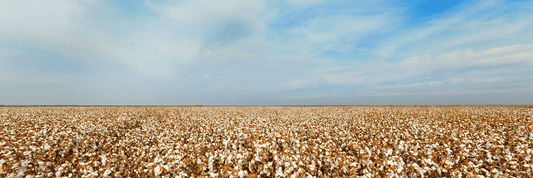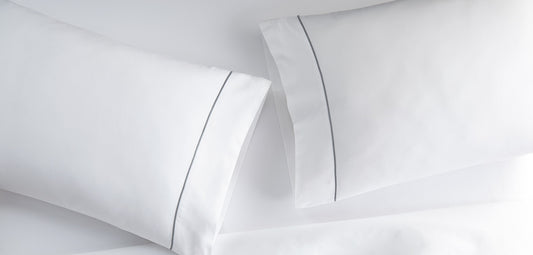Organic cotton is making waves in the textile industry as a preferred sustainable choice. This fabric is primarily known for its environmentally friendly appeal. It stands out as a greener alternative to conventional cotton. This rise in popularity reflects a growing consumer desire for products that are kinder to the planet.
But is organic cotton eco-friendly? Perhaps you've heard the buzz about how much water it takes to grow this versatile fiber. Or you may be questioning whether the term "organic" really means anything. Let's dive in and learn more about organic cotton and its impact on our world.

Organic Cotton Explained
Organic cotton stands out in the textile industry due to its sustainable cultivation methods. Unlike conventional cotton, it is grown without using synthetic pesticides or chemical fertilizers. This approach ensures that farming practices are less harmful to the environment. It promotes biodiversity and maintains soil health.
The popularity of organic cotton continues to grow. Both consumers and manufacturers are becoming more environmentally conscious. This trend is supported by initiatives that encourage sustainable agriculture practices worldwide.
Globally, the cultivation of organic cotton is spread across various countries. India, China, and Turkey are among the forefront producers. These nations have adopted organic practices to cater to the increasing global demand. Consumers drive the shift towards organic cotton. Today's buyers want to reduce the adverse environmental impacts associated with conventional farming. They also want to avoid exposure to harmful chemicals like synthetic pesticides.
Environmental Impact
Cotton is one of the world's most popular fibers. Yet, it is surrounded by environmental debates, particularly on its production impact. Let's explore the ecological footprint of organic versus conventional cotton. We'll examine critical aspects like water usage, soil health, biodiversity, and chemical use. We'll also shed some light on how these practices differ significantly between the two farming methods.
Soil Health and Biodiversity:
Organic cotton farming supports greater soil health and biodiversity. Organic growers avoid synthetic chemicals and rotate crops. These organic methods are broadly described as regenerative agriculture. They help to reduce erosion and increase soil fertility. Conventional methods often involve intensive cultivation and chemical inputs. They can lead to soil degradation and loss of biodiversity.
Chemical Use:
The use of synthetic pesticides and fertilizers is prohibited in organic farming. This protects the environment and the health of the farmers and communities around the farms. On the other hand, conventional cotton uses dangerous pesticides to protect the plants from damage. These chemicals contribute to significant environmental and health risks for everyone involved.
Water Usage:
On the surface, organic cotton reduces water consumption compared to conventional cotton. Approximately 70-80% of organic cotton is rain-fed. This minimizes reliance on artificial irrigation, thus conserving water. Conventional cotton relies heavily on irrigation, which can deplete local water sources. But all may not be as it seems on this point. More on this below.
The Water Consumption Debate

Consumers are beginning to note the environmental impacts of cotton production. The discussion around water usage in growing organic versus conventional cotton is vital.
Some studies show that organic cotton reduces water consumption compared to conventional cotton. Yet, the reality is that organic cotton might need more water than its standard counterparts. This discrepancy has to do with how much cotton fiber is actually produced per plant. Organic methods usually yield less cotton per acre than GMO, pest-resistant conventional cotton. This could imply a higher water use per unit of cotton produced if not managed properly.
According to Daniel Sumner, PhD, a distinguished professor of agricultural and resource economics at the UC Davis,
"The negative environmental effects caused by pesticides and fertilizers are lower for organic cotton. But organic cotton will have larger land and water footprints per bale, because of lower yields."
The Broader Picture
When considering the ecological footprint of organic cotton, it's essential to look beyond the fields. We must also consider the stages of transportation, processing, and retail. Organic cotton's environmental impact does not end at cultivation. Its entire lifecycle contributes to its sustainability profile.
Transportation and Processing
Organic cotton's sustainability is often touted from a cultivation standpoint alone. This view focuses on reduced chemical use and theoretically less intensive water use (see above). Yet, the carbon footprint expands significantly during transportation. Remember that the cotton must often travel long distances from producer to manufacturer to retailer. The energy consumed in these processes can diminish the initial environmental savings.
Retail Stage
The retail phase of organic cotton includes packaging and sales. It also contributes to cotton's ecological footprint, sometimes significantly. Some brands use eco-friendly packaging to mitigate impact, but most do not. If the store ships the cotton product to a consumer, this further adds impact. The energy consumption and waste generated through retail logistics can have a large impact.
Consumer Perspective
As consumers become more eco-conscious, we must make informed decisions about cotton products. Understanding the nuances of organic cotton can help identify genuinely eco-friendly options.

Tips for Identifying Genuinely Eco-Friendly Organic Cotton:
- Look for Certifications: Ensure products are certified by reputable organizations. Look for Global Organic Textile Standard (GOTS) or Organic Content Standard (OCS). These certifications guarantee that strict criteria are met during production.
- Research the Brand: Investigate the brand’s sustainability beyond how their cotton grows. Look for transparency in supply chain practices and commitments to reduced carbon footprints. These are good indicators of genuine eco-friendliness.
- Check the Full Lifecycle: Consider the product's entire lifecycle, from production through retail. Look for information on how the cotton is processed and whether the brand uses eco-friendly packaging and practices.
- Educate Yourself: Research the challenges and benefits of organic cotton. Compare various sustainable fabrics for a more comprehensive understanding of true eco-friendly fabrics.
OEKO-TEX® Certified Products

All Seasons Cotton Blanket

Diamond Towel Set

Soprano Sateen Sheet Set

Juliet Matelassé Coverlet
Summary
Throughout this discussion, we've explored organic cotton's environmental impact. Organic cotton promotes better soil health and reduces the use of harmful chemicals. Yet, it also faces challenges like potentially higher water usage due to lower yields. We must also consider significant carbon emissions during transportation and processing.
A Balanced View is Essential.
Consumers need a balanced perspective when evaluating the environmental impact of organic cotton. Understanding the benefits and limitations of organic cotton can lead to responsible choices. We must weigh organic cotton's advantages and disadvantages. We must consider how it can reduce pesticides alongside its broader ecological footprint. And we can't forget to include water and land use efficiency.
Consider the full scope of organic cotton's environmental impact. Check for credible certifications and transparent brand practices. By doing so, consumers can better navigate the complexities of eco-friendly textiles. This comprehensive approach ensures that environmental consciousness is not just a label. Instead, it's a practice that contributes to sustainable development.
References and Further Reading:
If you’d like to read more on the topic, here are a few links to check out:






















